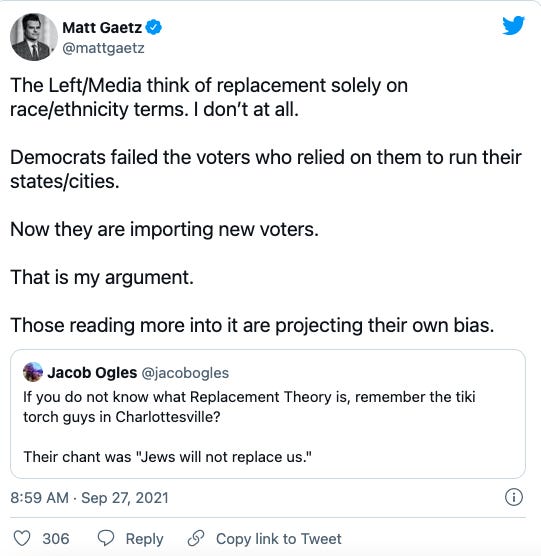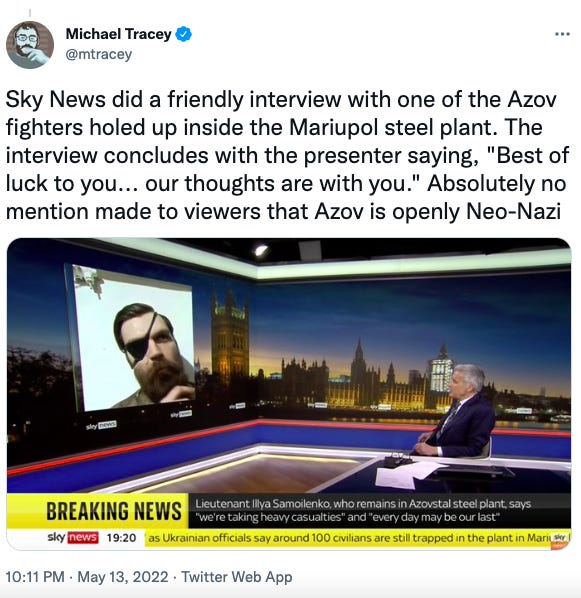Buffalo mass shooter/Twitter screengrab
On Saturday, a horrific act of terrorism was committed in Buffalo, New York. An 18-year-old gunman, Payton S. Gendron, is charged with opening fire on supermarket shoppers in a predominantly black neighborhood, killing 10 and wounding three. (All but two of the victims were black.) Gendron, who left a record of careful planning right down to outfitting himself in tactical gear and body armor, penned a “manifesto” in which he talks about white people in America being “replaced” by nonwhites.
Those who follow the news know that this is far from the first time “replacement theory” has figured in the ravings of a mass shooter. Other such incidents include the Christchurch, New Zealand massacre in 2018, in which shooter Brandon Tarrant, a 28-year-old old Australian, also wrote a “manifesto,” titled “The Great Replacement,” arguing that white Europeans had a right to fight against “racial and cultural replacement” by immigrants. (The concept was coined in 2011 by French extremist Renaud Camus.) The following year in El Paso, Texas, another shooter with a manifesto, 21-year-old Patrick Crusius, killed 23 people in a Walmart in a quest to thwart a “Hispanic invasion” of the United States. Replacement theory had also figured in the 2018 Tree of Life synagogue massacre in which 11 people died: the shooter, Robert Bowers, was obsessed with the idea that Jewish charities were helping bring “invaders that kill our people” to America .
We know these ideas are floating out there. We also know that, disturbingly, “replacement theory” is being mainstreamed on the right. We all remember that Fox News segment from April 2021 where Tucker Carlson openly and emphatically defended replacement theory with nutty metaphors like “well, what if you were a kid and you and your siblings saw your parents adopt a bunch of new kids, give them more stuff and treat them better, huh?”
We all remember Tucker insisting that yes, indeed, the Dems are “trying to ‘replace’ the current electorate … with new people, more obedient voters from the Third World.” Because, of course, those “voters from the Third World” are dumb sheep and couldn’t possibly do something like become swing voters or even shift Republican.
It's not a one-off, either. A few months later, in September 2021, Tucker Carlson was railing against “policy is called the great replacement, the replacement of legacy Americans with more obedient people from faraway countries” (he loves that “obedient” part, doesn’t he?) and actually calling it “the great replacement.”
And some Republicans in Congress—Florida’s Rep. Matt Gaetz, for one—were cheering on and joining the chorus, while insisting that “replacement” is not about race.
(“Obedient voters from the Third World”? Nope, nothing about race at all.)
Around the same time, No. 3 House Republican and newly minted MAGA zealot Elise Stefanik jumped on the bandwagon as well with a Facebook ad claiming that the Democrats were going to use amnesty for illegal immigrants to “overthrow our current electorate and create a permanent liberal majority in Washington.”
This is hateful, stupid, paranoid nonsense. It is also, need I point out, the epitome of collectivist “identity politics” the right sometimes likes to deplore in its progressive guises.
And no, it is not validated, as a few people have suggested to me, by the existence of the 2002 John B. Judis/Ruy Teixeira book, The Emerging Democratic Majority, which predicted a solid liberal majority because of, in part, a demographic shift toward a less white population. For one thing, predicting such a shift is not the same as calling for it or trying to engineer it. For another, the Judis/Teixeira predictions were based on much more than racial demographics; they saw the transition toward a knowledge economy as one of the key trends.
To what extent does racial violence driven by “replacement” fears feed on quasi-mainstream versions of this talk, as opposed to radicalized online spaces where killers’ manifestos are shared? (Gendron cited Tarrant as an inspiration.) It’s hard to say. But the mainstreaming of “replacement” discourse is very, very bad.
For what it’s worth, a startling poll released the other day shows that a third of American agree at least somewhat that “There is a group of people in this country who are trying to replace native-born Americans with immigrants who agree with their political views.” When these data are matched with concerns that “native-born Americans are losing economic, political, and cultural influence in this country because of the growing population of immigrants,” it appears that approximately 17 percent of Americans harbor strong “replacement theory” fears. How many of them are susceptible to Crusius/Gendron-style radicalization?
In a sane and decent political climate, both media figures and political figures on the right would quickly and emphatically disavow “great replacement” as un-American, race-baiting nonsense. Which means … don’t hold your breath.
That was a joke. Cue bitter laugh.
Speaking of race-baiting…
You know, I honestly don’t set out to do a Both Sides thing. But time and again, both sides do manage to suck, though not in the same way or to the same degree.
For instance, a lot of responses to the Buffalo shooting have been along these lines:
People. Come on.
Racial bias in policing is real, is due to a number of factors, and is an enormously complicated subject (one that I tried to explore in a long Bulwark article a year ago). But it does not manifest itself in cops coddling white mass shooters while callously gunning down unarmed black people—if only because you could easily find examples of the reverse.
For instance, accused New York subway gunman Frank James, who is black—who faces charges of shooting and wounding ten people in the April 12 attack—was apprehended alive. (At his court appearance on May 13, the judge greeted him with, “How are you doing today?”—a question that I could see eliciting considerable outrage if directed to a more “privileged” defendant.) Hunter Brittain, a white 17-year-old, was unarmed when he was fatally shot by a sheriff’s deputy in Arkansas during a traffic stop, apparently because he failed to comply with commands. Darrell Brooks, who is not charged with shooting anyone but with intentionally plowing his car through the Waukesha, Wisconsin Christmas parade last year, killing six and injuring nearly 50, was apprehended alive despite the fact that he is black and his victims were white. Hannah Fizer, an unarmed white Missouri woman, was shot and killed during a traffic stop in the summer of 2020 by a white police officer who said she had offered “verbal resistance” and claimed to have a gun. (She did not own one.) D.C. snipers John Allen Muhammad and Lee Boyd Malvo, who terrorized the Beltway area for three weeks in 2002 and killed ten people, were also apprehended alive and unharmed (Muhammad was executed in 2009 while Boyd, who was a juvenile at the time, is currently appealing his multiple life sentences.) Zachary Hammond, an unarmed 15-year-old, was gunned down by cops in 2015 during the bust of a possible marijuana sale.
And so on.
A lot of things go into why one arrest ends in a shooting and another doesn’t. Is racial bias, at least in the form of race-influenced perceptions of a person’s dangerousness, implicated? In some cases, no doubt it is. But there are plenty of other factors, including whether it’s a split-second decision or a slowly developing situation. The treatment of the Buffalo racial justice protester, Martin Guigno, is a particularly apples-and-oranges comparison: Guigno fell after being pushed aside when he repeatedly approached a column of officers moving forward. The shove looked needlessly forceful and nasty, but it’s far from clear that there was an intent to knock the 75-year-old off his feet. Yet, bizarrely, several people in the thread contrasting the two incidents asserted that the cops saw the racist shooter as one of “their own” or of “their friends.”
Is this stuff morally equivalent to members of Congress and a popular talk show host pushing Great Replacement paranoia?
No. No, it’s not.
But it promotes a polarizing and, yes, paranoid fact-free narrative that significantly distorts the complex problem of policing and racial bias.
Take your own advice, progressives, and do better.
The “Ukrainian Nazis” angle
Would you be shocked if I told you that some people tried to use the tragedy in Buffalo to push an anti-Ukraine narrative?
(You shouldn’t be. The nakedly opportunistic use of facts to push narratives is par for the course.)
But yes, they tried. For instance:
There’s a lot more along the same lines, from hardcore leftists and from contrarian members of the “intellectual dark web” who always feel compelled to question mainstream narratives.
First of all: it’s unclear whether the photo on the left is of Gendron, and other posts say that the “black sun” (Sonnenrad) symbol appeared on his manifesto, not his clothing.
As I’ve mentioned before: the Azov Regiment has a complicated history. A largely sympathetic recent piece in The Financial Times describes it as an “ultranationalist” military unit with “neo-Nazi roots.” Here, I can see a hundred people from anti-Ukraine Twitter howling that this is precisely the sort of absurd parsing you end up doing when you do pro-Ukraine spin: Oh, they’re not neo-Nazis, you see, they’re just “ultranationalists with neo-Nazi roots”!
But if you read the FT piece, the parsing actually does make sense.
“Azov’s history is rooted in a volunteer battalion formed by the leadership of a neo-Nazi group. But it is certain that Azov has depoliticised itself,” said Anton Shekhovtsov, a Vienna-based Ukrainian expert on Russia’s connections to Europe’s far-right. “Its history linked to the far-right movement is pretty irrelevant today.”
All this is debatable, and other people have questioned Shekhovtsov’s claim that Azov (which was folded into the Ukrainian armed forces in 2015) has really depoliticized. A 2019 Bellingcat investigation discusses some disturbing evidence of extremist ties, though a lot of it goes back to 2014-2015 (and there is no attempt to evaluate how many of the regiment’s fighters are implicated).
But to suggest, as professional Ukraine contrarian Michael Tracey did on Friday, that Azov is “openly neo-Nazi” is pretty absurd.
The word “openly” does mean something, no? It would seem to mean that Azov commanders are explicitly describing themselves as neo-Nazi or white supremacist. But they’re not. Even Azov militia founder Andriy Biletsky, who has been quoted as saying that in 2010 that Ukraine must “lead the white races of the world in a final crusade … against Semite-led Untermenschen,” has denied making the statement and currently boasts about how ethnically diverse Azov is.
Here's the bottom line. Right now, Azov is getting a lot of sympathetic attention because its fighters are taking a truly heroic last stand in besieged Mariupol, where Russian troops have the ones acting in a Nazi tradition (from bombing the city to rubble to herding forcibly deported civilians into prison camps). Sorry, Tracey, but I don’t think anyone is particularly interested in checking out the political credentials of every Azov fighter.
As a bonus, here’s Tracey getting spectacularly owned after claiming that the fighter in the interview that so offended him is wearing an eyepatch with an Iron Cross.




Azov 1: Tracey 0.












American conservatives has been directly tied to white supremacy since the days if the Second KKK. Buckley favored segregation, Nixon tried to undermine civil rights, Reagan gave a " states' rights" speech in Philadelphia MS, and so on. The latest wave is just the newest manifestation of this
I note Carlson's phrase "legacy Americans". Hmmm. Would that be the Natives of North America, who were replaced by white people, or the descendants of black people who arrived in 1619? I'm guessing not. It's more likely referring to Andy of Mayberry.